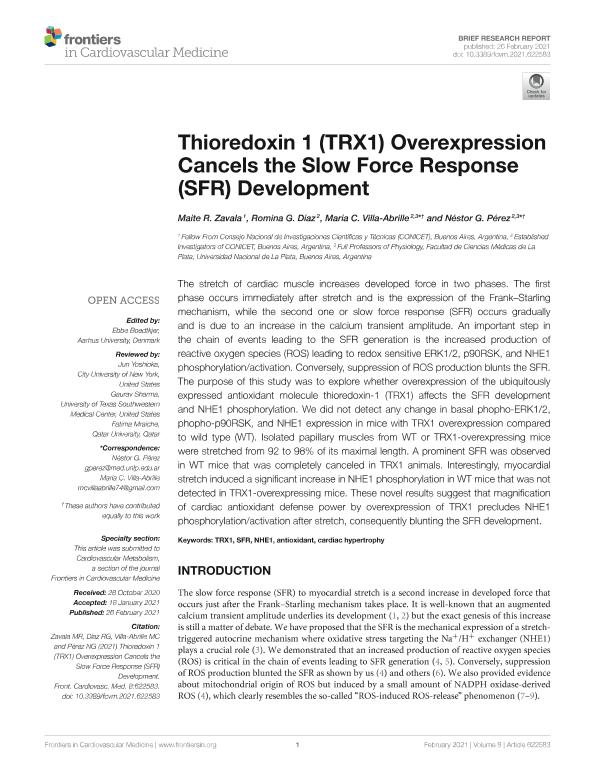Artículo
Thioredoxin 1 (TRX1) Overexpression Cancels the Slow Force Response (SFR) Development
Fecha de publicación:
02/2021
Editorial:
Frontiers Media
Revista:
Frontiers in Cardiovascular Medicine
e-ISSN:
2297-055X
Idioma:
Inglés
Tipo de recurso:
Artículo publicado
Clasificación temática:
Resumen
The stretch of cardiac muscle increases developed force in two phases. The first phase occurs immediately after stretch and is the expression of the Frank–Starling mechanism, while the second one or slow force response (SFR) occurs gradually and is due to an increase in the calcium transient amplitude. An important step in the chain of events leading to the SFR generation is the increased production of reactive oxygen species (ROS) leading to redox sensitive ERK1/2, p90RSK, and NHE1 phosphorylation/activation. Conversely, suppression of ROS production blunts the SFR. The purpose of this study was to explore whether overexpression of the ubiquitously expressed antioxidant molecule thioredoxin-1 (TRX1) affects the SFR development and NHE1 phosphorylation. We did not detect any change in basal phopho-ERK1/2, phopho-p90RSK, and NHE1 expression in mice with TRX1 overexpression compared to wild type (WT). Isolated papillary muscles from WT or TRX1-overexpressing mice were stretched from 92 to 98% of its maximal length. A prominent SFR was observed in WT mice that was completely canceled in TRX1 animals. Interestingly, myocardial stretch induced a significant increase in NHE1 phosphorylation in WT mice that was not detected in TRX1-overexpressing mice. These novel results suggest that magnification of cardiac antioxidant defense power by overexpression of TRX1 precludes NHE1 phosphorylation/activation after stretch, consequently blunting the SFR development.
Palabras clave:
ANTIOXIDANT
,
CARDIAC HYPERTROPHY
,
NHE1
,
SFR
,
TRX1
Archivos asociados
Licencia
Identificadores
Colecciones
Articulos(CIC)
Articulos de CENTRO DE INVEST.CARDIOVASCULARES (I)
Articulos de CENTRO DE INVEST.CARDIOVASCULARES (I)
Citación
Zavala, Maite Raquel; Diaz, Romina Gisel; Villa-Abrille, María Celeste; Perez, Nestor Gustavo; Thioredoxin 1 (TRX1) Overexpression Cancels the Slow Force Response (SFR) Development; Frontiers Media; Frontiers in Cardiovascular Medicine; 8; 2-2021; 1-7
Compartir
Altmétricas




